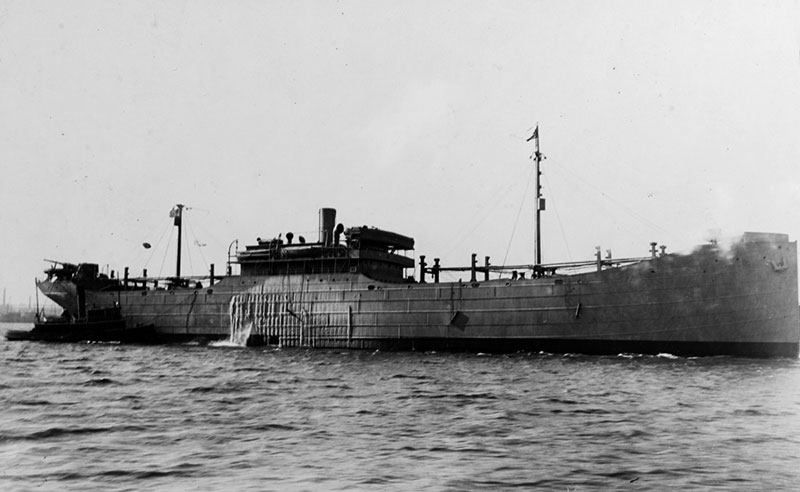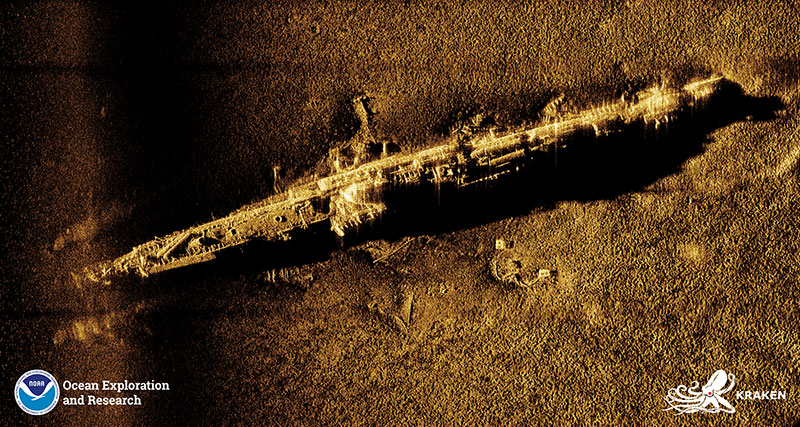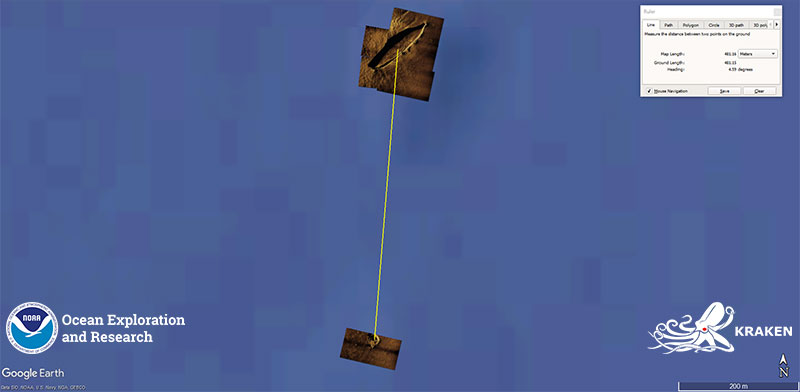
Rod Mather, University of Rhode Island Applied History Lab

USS Fairmont, later renamed Black Point, in harbor on a winter day, circa 1918-1919. Image courtesy of the U.S. History and Heritage Command. Download image (jpg, 270 KB).
The remains of the World War II German submarine U-853 and the American merchant ship/collier, Black Point, lie in Rhode Island Sound, about 6.25 nautical miles apart. The vessels were joint players in one of the final acts of the Battle of the North Atlantic during World War II.
The U-853 was a type IXC/40 German submarine launched on March 11, 1943, and commissioned June 25 that same year. She measured 251 feet, 10 inches in length; 22 feet, 6 inches in the beam; and drew 15 feet, 4 inches. The submarine was equipped with four torpedo tubes in the bow and two in the stern. She also carried a 4.1-inch deck gun and two anti-aircraft guns.
The Black Point was a 337-foot steel collier built in 1917 by the New York Shipbuilding Company in Camden, New Jersey. She was 55 feet in the beam and rated at 5,353 tons. The U.S. Navy requisitioned the vessel, originally named the Fairmont, in February 1918. After the war, she was returned to her original owner, only to be sold two years later to the Hawaiian Steamship Company of New York and renamed the Nebraskan. In 1927, Hawaiian Steamship Company sold her again, this time to C.H. Sprague of Boston. Her new owners renamed the ship the Black Point.
At the beginning of May 1945, the Black Point departed Newport News, Virginia, for Weymouth, Massachusetts, with her cargo holds full of coal. Although her commander, Charles E. Prior took a coastal route, not considering threats from German U-boats to be particularly severe. He was keeping with the common practice of navigating in a zig-zag pattern at the time of the submarine attack.
The U-853 participated in three patrols during the war. The last, under the command of Helmut Frömsdorf, intersected with the end of World War II in the Atlantic. By May 5, 1945, Adolph Hitler had committed suicide in his bunker in Berlin and Grand Admiral Karl Donitz was helping negotiate the terms of the Nazi surrender. On that day, Donitz issued a radio communique instructing all U-boats to cease attacks on Allied shipping and return to Germany. The U-853, which had earlier in the war fought off an attack from two British Swordfish torpedo bombers and had recently sunk the American patrol craft the PE-56, was now lurking in Rhode Island Sound.
It is unclear whether the German U-boat commander received Donitz’s order to cease attacks or whether he willfully ignored it. Either way, as the Black Point came into range off Point Judith, Rhode Island, at 5:40 pm on May 5, Frömsdorf fired a torpedo that upon impact blew away about 40 feet of the merchant ship’s stern. Fatally wounded, the Black Point sank, killing 12 of the 46 men on board.
Nearby vessels and shore stations witnessed the attack and raised the alarm. This triggered a hunt for the U-boat, but in a surprising twist, Frömsdorf did not flee the scene. In fact, he was still in Rhode Island Sound when the U.S. frigate Moberly (PF-63) and destroyer escorts Amick (DE-168) and Atherton (DE-169) commenced the hunt for the submarine 90 minutes after the Black Point sank.
Joined later by the destroyer Ericsson (DD440), the American task force detected, attacked, and destroyed the U-853. Today, the submarine lies on the ocean floor almost within sight of the former Newport Torpedo Station which helped develop and test the underwater technology used to destroy it.
The first divers to visit the wreck were deployed from the USS Penguin (ASR-12) in the hours immediately after the submarine sank. They confirmed the pressure hull had been breached and that the bodies of many of the 55 deceased German submariners were still on board the stricken vessel.

Synthetic Aperture Sonar imagery of the German U-853, showing that the submarine is largely intact. Image courtesy of Kraken Robotics. Download image (jpg, 7.8 MB).
The recent high-resolution mapping of the U-853 using Synthetic Aperture Sonar (SAS) on Kraken Robotics' KATFISH™ system confirms the submarine is largely intact and orientated in a northwest-southeast direction. The pressure hull is ruptured and accessible at multiple points. The forward torpedo loading hatch, battery hatch, and forward personnel hatch are all clearly visible, as is the conning tower, the aft gun mount, and several of the submarine’s compressed air flasks. Despite frequent disturbance as a popular dive site, the wreck retains archaeological integrity and to this day remains an important and poignant war grave.
The Black Point likewise serves as a war grave. High-resolution mapping of the site shows the vessel lying keel up on the ocean floor with the bow pointing to the northeast. Many of the individual hull plates are visible in the imagery. The much smaller stern section lies approximately 1,800 feet further south.

SAS imagery of the Black Point showing that the hull, including the bow, of the ship is largely intact and rests upside down on the seafloor. Image courtesy of Kraken Robotics. Download image (jpg, 9.0 MB).

Image showing the location of the main wreckage of the Black Point relative to a smaller section of the ship's stern, approximately 1,800 feet south. Image courtesy of Kraken Robotics. Download image (jpg, 377 KB).
The U-853 was one of the last German U-boats sunk in the Battle of the Atlantic and the last to be destroyed on the East Coast of the United States. The Black Point was the last American merchant ship sunk by a German U-boat. Together, these vessels represent the long battle for naval supremacy during World War II and the attempts by the Allies and the Third Reich to protect and/or disrupt their enemy’s Atlantic commerce and supply lines.